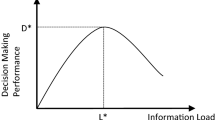Abstract
Decision-making in groups has great potential due to the possibilities for pooling ideas and sharing knowledge, but also great drawbacks due to the social pressures inherent in these situations that can limit free exchange of these ideas and knowledge. This paper presents two technology-based approaches to improving group decision-making, Second Messenger and AntiGroupWare. Second Messenger — a system that encourages groups to change their interaction styles during meetings — is designed to improve meetings, while AntiGroupWare — an on-line polling system that allows companies to gather information through flexible, iterative polling of its employees — is designed to avoid them altogether.
Similar content being viewed by others
References
Davis J H: 'Some compelling intuitions about group consensus decisions, theoretical and empirical research, and interpersonal aggregation phenomena: Selected examples, 1950—1990', Organizational Behavior and Human Decision Processes, 52, pp 3—38 (1992).
Janis I: 'Groupthink', Boston, MA, Houghton Mifflin (1982).
Surowiecki J: 'Board Stiffs', The New Yorker (8 March 2004).
Milgram S: 'Obedience to authority: An experimental view', New York, Harper and Row (1974).
Foushee M C: 'Dyads and triads at 35,000 feet: Factors affecting group process and aircraft performance', American Psychologist, 39, pp 885—893 (1984).
Asch S E: 'Studies of independence and conformity: I. A minority of one against a unanimous majority', Psychological Monographs, 70, No 416, p 70 (1956).
Isaacs E and Tang J C: 'What video can and cannot do for collaboration', Multimedia Systems, 2, pp 63—73 (1994).
O'Malley C, Langton S, Anderson A, Doherty-Sneddon G and Bruce V: 'Comparison of face-to-face and video mediated interaction', Interacting with Computers, 8, pp 177—192 (1996).
Rocco E: 'Trust breaks down in electronic contexts but can be repaired by some initial face-to-face contact', Conference on Human Factors in Computing Systems (CHI98), Los Angeles (1998).
Kiesler S and Sproull L: 'Group decision making and communication technology', Organizational Behavior and Human Decision Processes, 52, pp 96—123 (1992).
Ochsman R B and Chapanis A: 'The effects of 10 communication modes on the behavior of teams during co-operative problem-solving', International Journal of Man-Machine Studies, 6, pp 579—619 (1974).
Siegel J, Dubrovsky V, Kiesler S and McGuire T W: 'Group processes in computer-mediated communication', Organizational Behavior and Human Decision Processes, 37, pp 157—187 (1986).
Reid F, Ball L et al: 'Styles of group discussion in computer-mediated decision making', British Journal of Social Psychology, 36, pp 241—262 (1997).
Hollingshead A B: 'Information suppression and status persistence in group decision-making — the effects of communication media', Human Computer Research, 23, pp 193—219 (1996).
Dennis A R, George J F, Jessup L M, Nunamaker J F and Vogel D R: 'Information technology to support electronic meetings', MIS Quarterly, 12, pp 591—624 (1998).
Connolly T, Jessup L M and Valacich J S: 'Effects of anonymity and evaluative tone on idea generation in computer-mediated groups', Management Science, 36, pp 97—120 (1990).
Jessup L M, Connolly T and Galegher J: 'The effects of anonymity on GDSS group process with an idea-generating task', MIS Quarterly, 14, pp 313—321 (1990).
DiMicco J M and Bender W: 'Second Messenger: Increasing the Visibility of Minority Viewpoints with a Face-to-face Collaboration Tool', Proceedings of the ACM Conference on Intelligent User Interfaces (2004).
DiMicco J M, Pandolfo A and Bender W: 'Influencing Group Participation with a Shared Display', Proceedings of the ACM Conference on Computer Supported Cooperative Work (CSCW 2004) (in submission).
Brown B B: 'Delphi Process: A methodology used for the elicitation of opinions of experts', Santa Monica, CA, Rand Corporation (1968).
Delbecq A L, Van de Ven A H and Gustafson D H: 'Group techniques for program planning', Glenview, IL, Scott, Foresman (1975).
About this article
Cite this article
Norton, M.I., DiMicco, J.M., Caneel, R. et al. AntiGroupWare and Second Messenger. BT Technology Journal 22, 83–88 (2004). https://doi.org/10.1023/B:BTTJ.0000047586.77595.87
Issue Date:
DOI: https://doi.org/10.1023/B:BTTJ.0000047586.77595.87




